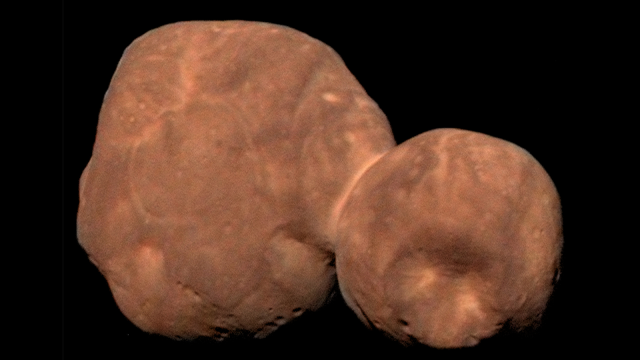Nothing you encounter is truly “pristine.” Nearly every atom on our planet has been processed in some way, either by humans, the Sun, Earth’s core, or other influences. But on New Year’s Day 2019, the New Horizons mission flew past one of the most pristine objects in the solar system: Arrokoth, an object far beyond Pluto that has remained largely undisturbed since it first formed billions of years ago.
Today, scientists are releasing a trio of papers (1, 2, 3) digging deep into Arrokoth’s properties, its geology, and how it formed. Not only do they shed light on the true nature of the icy Kuiper Belt Objects in the distant solar system, but they provide strong evidence for a theory on how planets form more generally.
“We have made a major breakthrough in understanding the process of how planetary formation works,” Alan Stern, principal investigator of the New Horizons mission, told Gizmodo.
Astronomer Marc Buie discovered Arrokoth, formerly called MU69, using the Hubble Space Telescope in 2014. The rock is a cold classical Kuiper Belt Object, an object in the distant Kuiper Belt with a circular, relatively unmodified orbit outside the influence of Neptune’s gravity. The New Horizons team targeted the object as the followup to their Pluto mission. As it zipped by the object, the space probe examined it with a suite of imagers, plasma and dust detectors, and radio receiver.
[referenced url=” thumb=” title=” excerpt=”]
The original Hubble image of Arrokoth showed just a speck. After much speculation to what the object might look like up close, the flyby revealed a 36-kilometre-long flattened dumbbell with no nearby satellites, rings, or dust, with spots and pits of varying brightness. Today, researchers have built on those initial results with a deep dive into the object’s nature, using further data beamed back to Earth by New Horizons.
Arrokoth’s uniform red surface shows off methanol ice and organic materials but no detected water, according to one of the three papers published today in Science. Craters and depressions with lighter-coloured material pockmark its relatively smooth surface (which does have some fissures and hills) and seem to date back to the solar system’s earliest era, at least 4 billion years ago. Unlike other comets and asteroids that show erosion from the Sun’s heat and high-energy impacts, Arrokoth’s surface seems to be the result of lower-energy interactions between slow-moving objects.
The data allowed physicists to write a fuller story behind how Arrokoth formed. A cloud of lots of small, solid particles would have collapsed into a pair of co-orbiting rocks, based on the lobes’ alignment. These rocks would have slowly lost momentum, perhaps from friction with other particles in the gas cloud, and merged into the final bi-lobed shape. There’s no evidence that the lobes compressed from a high-speed impact when they came together.
Finding an object so starkly showing off evidence of its formation could have profound consequences for our understanding of planetary formation more generally. According to one of the papers, it “informs the accretion processes that operated in the early Solar System.” In other words, this process could be how the planets formed, as well.
Stern told Gizmodo that if knowledge gained from Arrokoth applies to other objects in the solar system, it would be enough to rule out other theories of planetary formation, like the hierarchical accretion by which planets form from the collision of increasingly large, random pieces (versus what the evidence shows in the case of Arrokoth: a cloud collapsing).
This is an exciting set of research that’s giving scientists a deep look into the primordial solar system, said Kat Volk, associate staff scientist at the University of Arizona’s Lunar and Planetary Laboratory who was not involved with these papers. She told Gizmodo she is also excited about how the astronomers were able to build a preliminary model of what kinds of objects were producing the craters on Arrokoth.
But Arrokoth is just one object. “The primary question is: We reached into a bag of green marbles. Did we get a green marble or did we get a weird alternate?” Stern said. Basically, we don’t know how typical an object Arrokoth is just yet.
The only way to answer that question is to visit another Kuiper Belt Object, and the New Horizons team is currently looking for their spacecraft’s next target.
